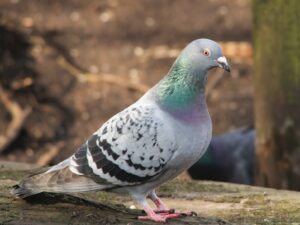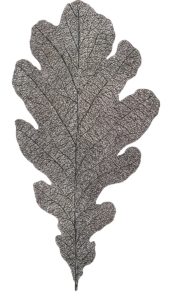Favianna Rodriguez grew up in East Oakland, in a polluted neighborhood with hardly any trees and not many places to play outside. It’s a town she continues to call home.
“Reality in this country for so many people of color is not having access to nature,” says Rodriguez, an activist and artist. “My dream is to create art in beautiful, natural spaces—art that is also an invitation to play and to reimagine those spaces.”
Rodriguez’s dream is becoming reality. This weekend, on Sunday, July 17, the new 14-acre Tunnel Tops park opens to the public in San Francisco’s Presidio, a former military base turned urban national park that hosts around 10 million visitors a year. The Presidio spans 1,500 acres, about 5 percent of San Francisco, sprawling at the southern end of the Golden Gate Bridge.
Opening day at the innovative park, eight years in the making, will include a National Park Service ranger talk at the campfire circle, food, and music and dance performances. Among the new attractions, Tunnel Tops features vibrant, larger-than-life outdoor murals by Rodriguez, titled Ancestral Futurism. One of the murals includes a banner reading, “Welcome to the homeland of the Ramaytush Ohlone,” referring to the Indigenous people who first lived on the San Francisco peninsula. The lively, colorful artworks are part of the Presidio’s efforts to reimagine what it means to be an accessible, inclusive urban national park. The design process for Tunnel Tops was built around input from San Franciscans who have historically felt unwelcome in the Presidio.
Tunnel Tops cost $118 million dollars to build, with $20 million dollars of public funding coming from the Presidio Trust and $98 million raised by the Golden Gate National Parks Conservancy.
The park drapes across the top of the tunnels containing roaring Highway 1, connecting the San Francisco Bay shoreline and restored tidal marshes to the rest of the Presidio.
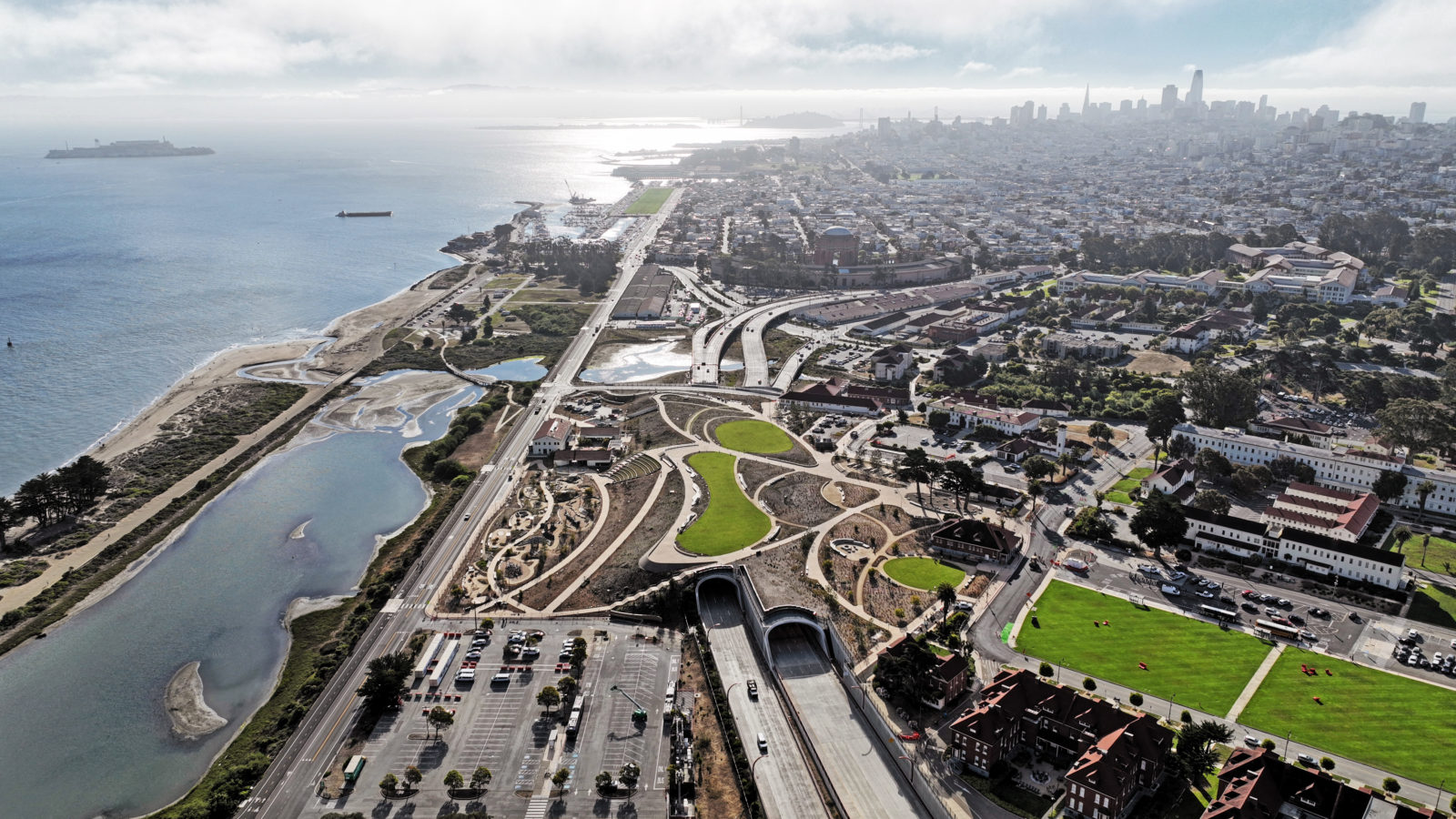
“The opportunity became to create a gateway to the Presidio, to connect the historic heart and wild edge of the park,” says Michael Boland, the Presidio Trust’s Chief of Park Development and Visitor Engagement.
Tunnel Tops creates safe passage over the freeway for pedestrians, plants, and wildlife. Lew Stringer, Presidio naturalist and consultant on the flora for Tunnel Tops, prioritized choosing plants that would help make the park a wildlife corridor and a haven for pollinator insects.
“When the Highway separated that area, it really created an ecological disconnect,” says Stringer. “We want these plants to create an inviting landscape that will feel like a gorgeous garden.”
Tunnel Tops’s embankment is studded with native coastal scrub species such as sagebrush (Artemisia tridentata) and purple self-heal flowers (Prunella vulgaris), as well as drought-tolerant, nonnative trees and shrubs. Nearly two miles of wide, curving paths meander through the gardens past iconic Golden Gate views, from colonial buildings and a public transit stop at the top of the slope to a playground and the Bay shoreline at the bottom.
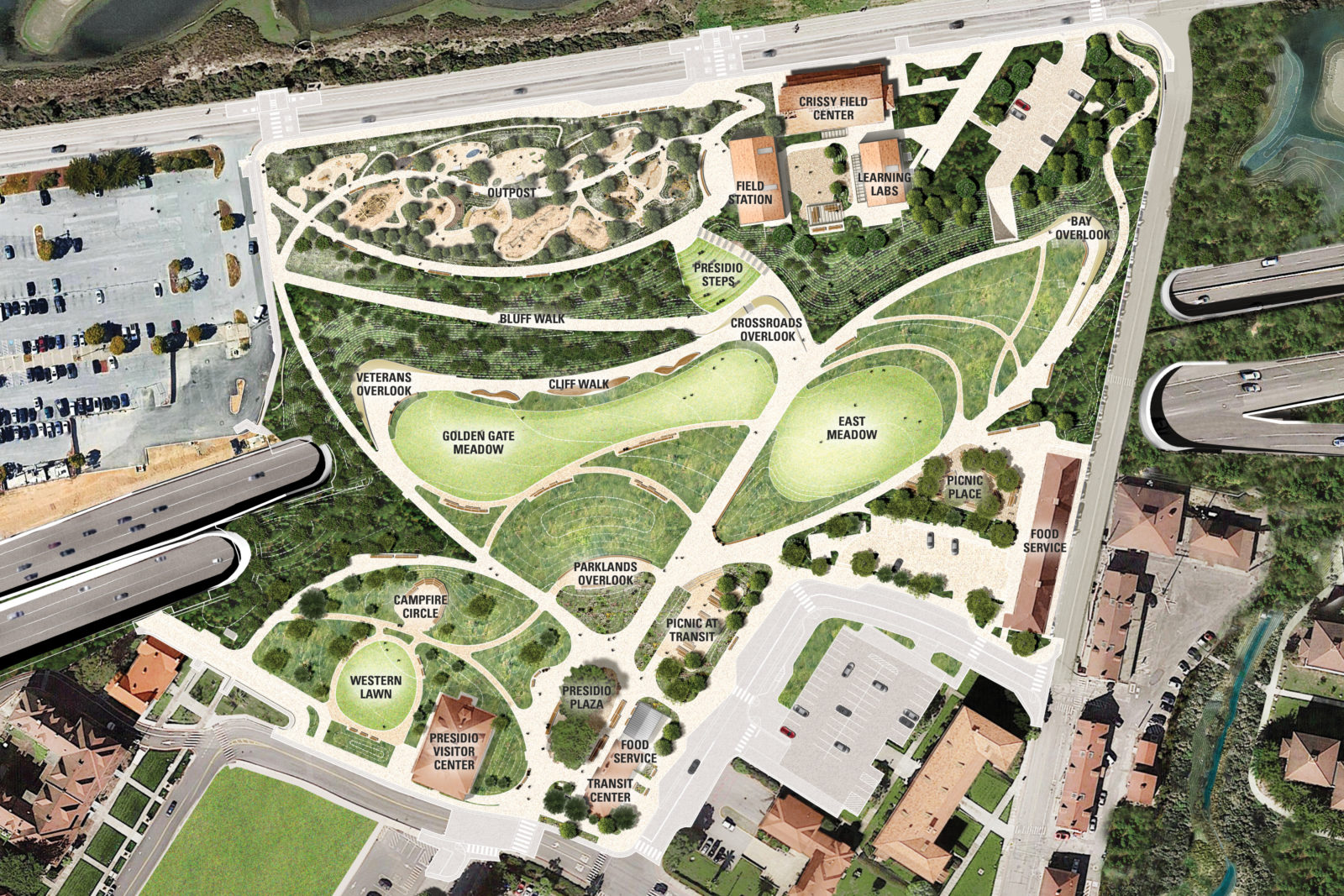
Rodriguez hopes that her artwork and the design of Tunnel Tops will inspire visitors to connect with nature and their sense of place in new ways, and invite future park project leaders to reconsider what a successful park looks and feels like.
“When I think of whiteness and how it operates, it’s about imposing a monoculture,” says Rodriguez. “But as an environmentalist, I know that monoculture is what kills us. Biodiversity is what we need — and similarly when it comes to representation and cultural diversity. That is what’s going to strengthen the park.”
Signs throughout Tunnel Tops read Welcome to Your National Park. But what does it mean to be a national park, especially one that is inclusive and accessible, in the densely populated urban San Francisco Bay Area?
In 2021, the Presidio invited 13 community leaders to become the Presidio Activator Council. The Activators gathered to envision a national park that would serve their communities and discuss what programs, spaces, and cultural events would make visitors feel welcome. The Activators represent a variety of communities that have been excluded from national parks, including Indigenous groups, immigrant and refugee advocates, environmental justice activists, and neighborhood organizations. As a member of the council, Rodriguez says the Activators’ involvement felt transformative.
“Outdoor spaces are trying to get in right relationship with communities that were previously not welcomed,” says Rodriguez. “When there’s a goal to invite more communities of color, art and culture is how you do that.”
Rodriguez was surprised by the Presidio’s willingness to make big changes in the design and operation of Tunnel Tops. This includes partnering with community organizations to bring food carts, hip hop, and festivals to the park, as well as extending the MUNI 43 and 30 bus routes and providing a free shuttle to downtown San Francisco to make it accessible to visitors without cars.
In the early design stages, the Presidio commissioned five concepts for the Tunnel Tops park. The designs were presented at workshops in parts of the city whose residents have traditionally not visited the Presidio. These were mostly low-income neighborhoods, predominantly home to people of color. About 10,000 people from all over San Francisco participated in the design workshop process.
In the community workshops, participants said they wanted Tunnel Tops to be a place where they could bring the whole family for free and spend the day together. They wanted multigenerational activities, beautiful gardens, unique experiences they couldn’t have in their own neighborhood parks, and iconic views.
As a result, the park features clusters of picnic tables long enough to host family gatherings, a nature center and playground with hands-on activities for kids, and sweeping views of the Golden Gate Bridge and Marin Headlands. Tucked into a hilly nook, a fire ring is surrounded by boulders. Community members wanted a distinctive national park experience like ranger naturalist talks around a campfire. There are plans for campfire events led by Indigenous storytellers.
Rodriguez says culture is key in changing our relationship to nature and improving park accessibility, especially for communities of color.
“The Presidio is beautiful, but it also has this kind of sterile vibe … it reflects a white conservation aesthetic that we’ve seen over and over again in many different parks,” Rodriguez says. “You need more art throughout the park, to make it a more fun and inviting place, and you need more color.”
Rodriguez created temporary murals for Tunnel Tops that will remain in place for three months. The installations are made up of vivid, person-sized stickers created from UV-resistant aluminum that conforms to the texture of the cement beneath. The stickers transform the plaza between the playground and nature center into a collage bursting with tantalizing organic shapes, plants, and animals.
In creating the murals, Rodriguez consulted with Ramaytush Ohlone leaders, discussing the cultural and ecological significance of local animals and plants. Some of the creatures shown in Ancestral Futurism are still around, like hummingbirds and coyotes, but it also features animals that no longer roam the Presidio, like grizzly bears and tule elk. In this vibrant patchwork, past and present come together to create a pattern that represents a thriving ecosystem.
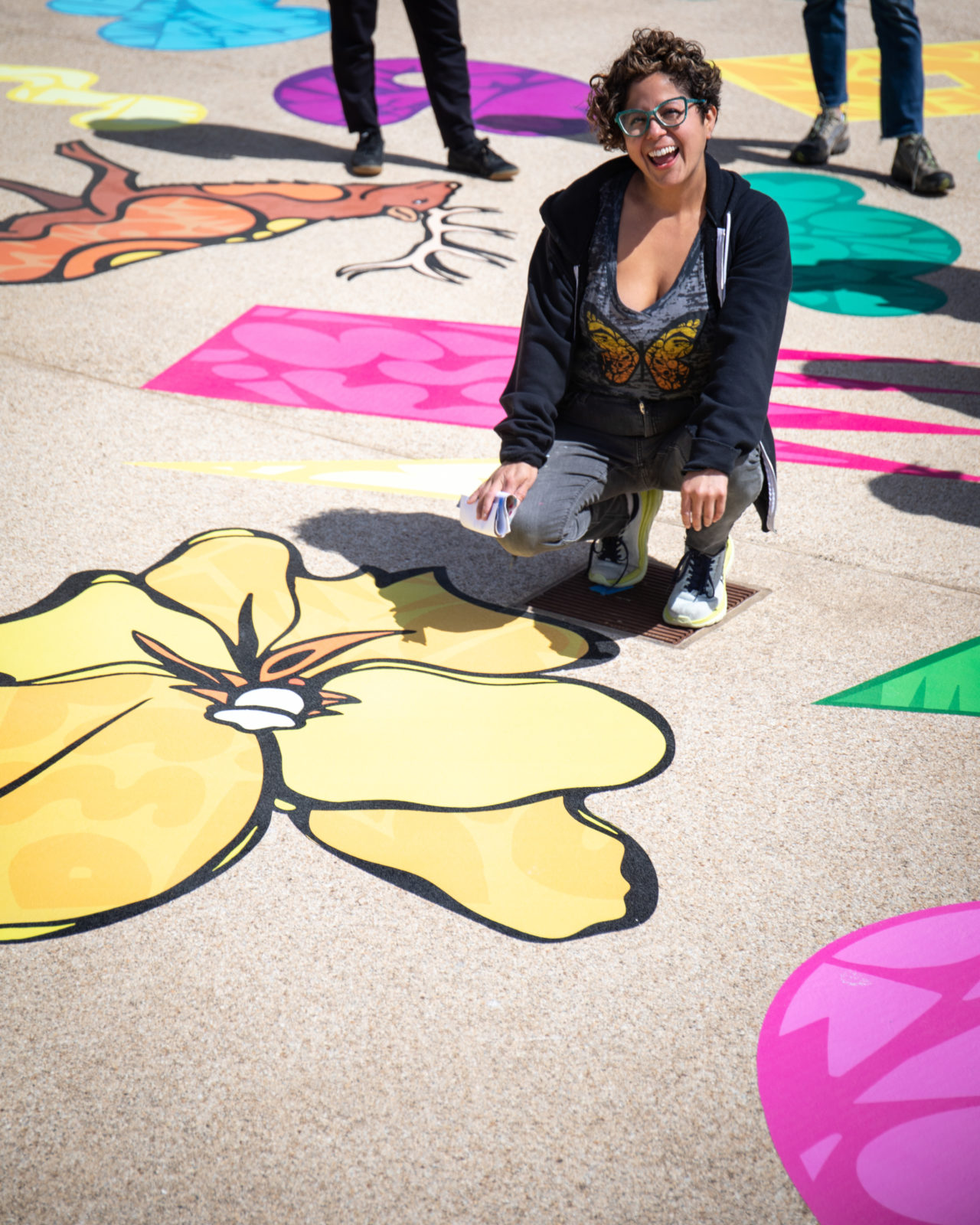
“What Ancestral Future means is that in order to look forward, we have to look back,” says Rodriguez. “We have to honor the ancestral wisdom of the region, and lift it up, because that’s what’s going to help inform the future.”
The future of San Franciscans’ connection to nature, however, seems to be in peril. In the design workshops, Presidio Trust’s Boland heard deep concerns about urban children growing up alienated from the natural world. As a result, one of Tunnel Tops’s most striking features is the Outpost, a playground built from rocks, wood, water, and sand.
Each play structure in the Outpost is based on an element of the Presidio’s history or ecology. For example, a water feature was inspired by the Presidio’s historic role as the original source of San Fansisco’s drinking water. Children can climb on or crawl into a fort made from elegant tangles of wood that emulate oriole nests found in the Presidio’s palm trees. A 250-year-old oak tree that blew down in a storm has been turned into a climbing structure.
“Climbing a tree is one of those classic experiences,” says Boland. “A kid growing up in the Tenderloin — there are no trees for them to climb. Most city parks don’t allow climbing trees. What we’re trying to do is deliver those classic experiences to urban kids.”
Rodriguez was delighted when, on the same day it was installed, kids began playing on Ancestral Futurism, jumping from shape to shape.
“I created that art for kids to play,” Rodriguez says. “I’m hoping that they will get curious, they’ll lay down on the floor next to the mountain lion and wonder who this creature was.”




